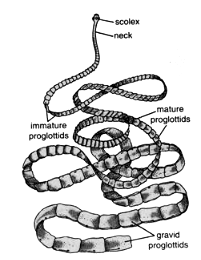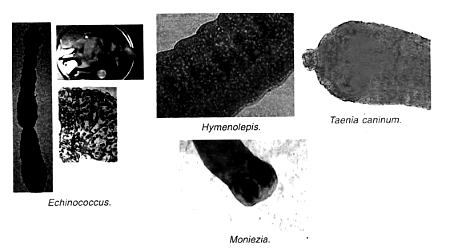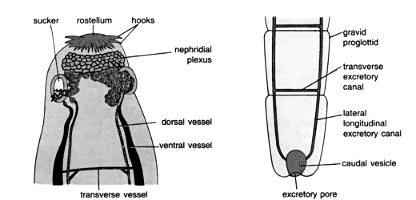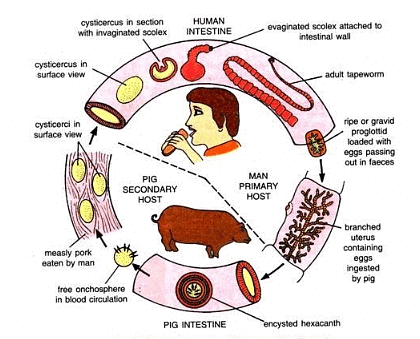Platyhelminthes: Taenia Solium | Zoology Optional Notes for UPSC PDF Download
Habit and Habitat
Taenia solium is an endoparasitic tapeworm that resides in the small intestine of its primary host, which is humans. The adult tapeworm lives in the human gastrointestinal tract. Its larvae can also infect other animals, including pigs, when humans shed the eggs in their feces.

In pigs, the larvae form cysts in various tissues, which can be transmitted back to humans when they consume undercooked or raw pork. This complex life cycle is an adaptation that allows the tapeworm to complete its life cycle and reproduce.
Structure of Taenia Solium
Scolex: The anterior end of Taenia solium has a scolex, which is a knob-like structure equipped with muscular suckers and a rostellum with hooks. These structures are used for attachment to the intestinal wall of the primary host.
Neck: The scolex is followed by a narrow, unsegmented neck that continuously produces new proglottids through asexual budding or transverse fission. This area is essential for the tapeworm's growth and reproduction.
Strobila: The strobila makes up the majority of the tapeworm's body and consists of a linear series of proglottids. It's typically about two to three meters long in mature individuals and contains hundreds of proglottids. Proglottids are the repeating units of the strobila and are produced in the neck region.
Proglottids: Proglottids are individual segments of the tapeworm, each containing a full set of reproductive organs. They are classified into three types: immature, mature, and gravid. Immature proglottids are closer to the neck and lack reproductive organs. As proglottids move away from the neck, they become mature and then gravid. Gravid proglottids are filled with fertilized eggs and are periodically shed from the tapeworm.

Body Wall of Taenia Solium
The body wall of Taenia solium consists of several layers and structures:
Cuticle: The cuticle is the outermost layer and provides protection to the tapeworm. It is thick and waxy and is resistant to digestive enzymes. It is made up of protein impregnated with calcium carbonate and contains microtriches (fine thread-like spines). The cuticle consists of three layers: an outer comidial layer, a middle homogeneous layer, and an inner basement membrane.
Sub-Cuticular Muscles: Located just below the basement membrane of the cuticular layer, these muscles include outer circular and inner longitudinal muscle layers. There are also muscle fibers in the parenchyma, providing additional musculature.
Sub-Cuticular Cells: These long-necked cells secrete the cuticle. They open just below the basement membrane.
Parenchyma or Mesenchyma: The parenchyma forms a spongy network of mesenchyme cells filled with fluid. This fluid maintains the tapeworm's body form and contains calcareous lime cells that neutralize host digestive enzymes. The mesenchyme cells are also involved in forming the reproductive organs.
The body wall serves various functions, including protection, anchoring to the host's intestinal wall, absorbing nutrients from the host's intestine, and maintaining the tapeworm's shape. The microtriches on the cuticle increase the surface area for absorption.
 In summary, Taenia solium is a parasitic tapeworm that exhibits specific adaptations for its parasitic life cycle in the human digestive tract. Its complex life cycle, structure, and body wall help it survive and reproduce in its hosts.
In summary, Taenia solium is a parasitic tapeworm that exhibits specific adaptations for its parasitic life cycle in the human digestive tract. Its complex life cycle, structure, and body wall help it survive and reproduce in its hosts.
Nutrition in Taenia Solium
Taenia solium, like other tapeworms, lacks a traditional alimentary canal or a digestive system. Instead, it practices saprozoic nutrition, a form of parasitism in which it absorbs predigested liquid nutrients directly from the host's intestinal contents through its body surface. The tapeworm primarily absorbs nutrients such as glucose, amino acids, and glycerol, which are already digested by the host, especially in the ileum, the final part of the small intestine.
- The scolex of Taenia solium, being anchored into the host's intestinal mucosa, also contributes to nutrient absorption, which can include tissue fluids. These absorbed nutrients are used for the tapeworm's metabolic processes.
- The tapeworm stores reserve food in the form of glycogen and lipids in its parenchyma. This stored energy can be used when nutrients are scarce or during periods when the tapeworm is not actively feeding.
Respiration in Taenia Solium
The respiration of Taenia solium is anaerobic, as it lives in the oxygen-poor environment of the host's intestinal contents. This means that it doesn't rely on oxygen for its metabolic processes. Instead, it derives energy from the breakdown of glycogen, a stored energy source, within its cells.
- During the breakdown of glycogen, waste products are generated, including carbon dioxide, fatty acids, and other organic acids. Carbon dioxide, a metabolic waste product, is diffused out through the general body surface of the tapeworm. Fatty acids and other waste products are eliminated through the excretory system.
- Interestingly, when free oxygen is available, Taenia solium can consume oxygen. This consumption of oxygen is most significant in the anterior proglottids (the segments closest to the scolex) and gradually decreases towards the posterior end of the tapeworm. This oxygen consumption is not part of its usual anaerobic metabolic pathway but is a response to the presence of oxygen.
Nervous System of Taenia solium
- The nervous system of Taenia solium is relatively simple. It consists of a pair of small cerebral ganglia located in the scolex, connected by a transverse nerve band, as well as dorsal and ventral commissures. These structures together are referred to as the brain complex.
- The brain complex is connected to a rostellar nerve ring, which includes a pair of rostellar ganglia in the rostellum (the anterior part of the scolex). Eight nerves connect the brain complex with the rostellar nerve ring. Nerve fibers from the cerebral and rostellar ganglia innervate the suckers and rostellum, helping with attachment and sensory perception.
- From the posterior side of the brain complex, five pairs of longitudinal nerve cords arise, running along the strobila. Among these, two lateral longitudinal nerve cords are well-developed and travel the entire length of the strobila, lying just outside the longitudinal excretory canals. These nerve cords play a role in coordinating the movements and functions of the proglottids along the body.

Although Taenia solium lacks specialized sense organs, it possesses numerous free nerve endings throughout its body to detect and respond to stimuli.
Excretory System of Taenia Solium
The excretory system of Taenia solium is involved in regulating the fluid balance within the tapeworm's body, which also plays a role in osmoregulation. The key components of the excretory system are as follows:
Excretory Vessels: There are four longitudinal excretory vessels, with two dorsal vessels and two ventral vessels. The dorsal vessels exist primarily in the anterior part of the strobila. The ventral vessels run along the entire length of the tapeworm.
Nephridial Plexus: The excretory vessels are joined in the scolex by the nephridial plexus.
Transverse Excretory Canal: The two ventral excretory vessels are connected by a transverse excretory canal in the posterior margin of each proglottid.
The excretory canals are lined by cuticle and are non-ciliated, meaning they lack cilia for movement. Instead, small ciliated branches feed into the canals, and they branch into fine capillaries, ending in characteristic flame cells found throughout the parenchyma. Flame cells have long cilia that flicker and maintain hydrostatic pressure within the tapeworm's body. This pressure helps drive waste products, such as fatty acids and organic acids, into the excretory canals. The carbon dioxide produced during the anaerobic respiration is also eliminated through the general body surface, as mentioned earlier.In the final proglottid of the strobila, there is a bladder or caudal vesicle that opens to the exterior via an excretory pore. However, when this proglottid is shed from the tapeworm, the caudal vesicle is lost, and the ventral excretory canals open independently to the outside.
Flame cells have long cilia that flicker and maintain hydrostatic pressure within the tapeworm's body. This pressure helps drive waste products, such as fatty acids and organic acids, into the excretory canals. The carbon dioxide produced during the anaerobic respiration is also eliminated through the general body surface, as mentioned earlier.In the final proglottid of the strobila, there is a bladder or caudal vesicle that opens to the exterior via an excretory pore. However, when this proglottid is shed from the tapeworm, the caudal vesicle is lost, and the ventral excretory canals open independently to the outside.
The excretory system in Taenia solium thus plays a crucial role in maintaining osmotic balance and eliminating waste products.
Reproductive System of Taenia Solium
The reproductive system of Taenia solium is one of the notable features of this tapeworm, as it displays hermaphroditism in mature proglottids, meaning that each proglottid contains both male and female reproductive organs. Here's a detailed description of the male and female reproductive organs in a mature proglottid:
Male Reproductive Organs:
Testes: Numerous small, spherical testes are found scattered throughout the parenchyma of the proglottid, primarily towards the dorsal side. While some researchers argue that there is a single branched testis, in the present description, the individual spherical follicles have been referred to as testes.
Vasa Efferentia: From each testis, tiny capillary structures called vasa efferentia originate. These vasa efferentia from surrounding testes unite to form a common sperm duct, roughly in the middle of the proglottid.
Vas Deferens: The common sperm duct, known as the vas deferens, follows a convoluted path and opens into the cirrus.
Cirrus and Cirrus Sac: The cirrus, also referred to as the penis, is a muscular, extendable organ through which the vas deferens continues. It is surrounded by the cirrus sac. The cirrus is protrusible, allowing it to be extended for reproductive purposes. The cirrus opens through the male gonopore into a cup-shaped genital atrium located more or less in the middle of the proglottid, near its lateral margin.
Female Reproductive Organs:
Ovary: The ovary, also known as the germarium, is bilobed and located ventrally in the posterior part of the proglottid. The two lobes are connected by a transverse structure called the ovarian bridge or isthmus. Each lobe of the ovary consists of multiple radially arranged follicles.
Oviduct: A median short but wide oviduct arises from the middle of the ovarian bridge. This oviduct opens into the ootype.
Ootype: The ootype is a small, spherical bulb-like structure located at the junction of the oviduct, uterus, and vitelline duct. It serves as a site for the maturation of eggs.
Vagina: The vagina is a narrow tubular structure that runs slightly obliquely inwards from the female gonopore within the genital atrium. It dilates to form a seminal receptacle, which temporarily stores sperm, and then continues as a narrow short fertilizing duct to join the oviduct.
Uterus: The uterus is a blind, club-shaped, sac-like structure that originates from the ootype and extends towards the anterior side of the proglottid. In gravid (pregnant) proglottids, it becomes highly branched with 7 to 10 branches. The uterus is the site where fertilized eggs are packed and ultimately released.
Vitelline Gland: The vitelline gland is a large, lobulated glandular mass located at the posterior margin of the proglottid. It produces yolk material that is essential for the development of eggs. A median vitelline duct originates from the vitelline gland and joins the ootype.
Mehlis's Glands: These are unicellular glands that surround the ootype. They play a role in the secretion of substances that are part of the egg formation and development process.
In summary, Taenia solium, like other tapeworms, possesses a complex reproductive system that facilitates both male and female functions within each proglottid. The coordinated interplay of these reproductive organs allows for the production, fertilization, and release of eggs, ultimately continuing the life cycle of the tapeworm.
Life History of Taenia Solium
The life history of Taenia solium, also known as the pork tapeworm, involves a complex series of stages that require multiple hosts for its completion. Here's an overview of the life history of Taenia solium:
- Copulation and Fertilization:
- Taenia solium is hermaphroditic, meaning that each mature proglottid contains both male and female reproductive organs.
- Self-fertilization may occur when the cirrus (penis) of one proglottid inserts into the vagina of the same proglottid.
- Cross-fertilization between different proglottids of the same tapeworm is common.
- The testes mature first, and after copulation, sperm is stored temporarily in the seminal receptacle.
- Formation of Egg Capsules:
- After fertilization, the zygote is surrounded by yolk material in the ootype, which receives this yolk from the vitelline glands.
- The zygote and yolk material form a capsule with a thin shell or chorionic membrane.
- The capsule passes into the uterus where it is packed with thousands of egg capsules.
- The secretion of Mehlis's glands aids in the passage of capsules in the uterus.
- Development of Taenia:
- Within the uterus, the zygote undergoes unequal divisions, forming megameres, mesomeres, and micromeres. These cells have distinct roles.
- A morula is formed with micromeres at the center, surrounded by mesomeres and then megameres.
- The megameres fuse to form the outer embryonic membrane, which eventually disappears.
- The mesomeres become the inner embryonic membrane (embryophore), which is thick, hard, cuticularized, and striated.
- An embryo develops with six chitinous hooks at its posterior end, which are secreted by specialized cells called onchoblasts.
- This six-hooked embryo is known as the hexacanth and is enclosed in an onchosphere, which consists of the hexacanth, hexacanth membranes, basement membrane, embryophore, and the egg shell or chorionic membrane.
- Transmission to Secondary Host:
- The onchospheres are released when the gravid proglottids or onchospheres are consumed by pigs or other hosts that engage in coprophagy (consuming feces).
- The hexacanths bore through the intestinal wall, enter the host's bloodstream, pass through the heart, and ultimately settle in the host's striated muscles.
- Here, they lose their hooks, enlarge, and become encysted in a cuticular covering, forming cysticerci or bladderworms.
- Cysticercus or Bladder-Worm:
- The cysticercus is the larval stage of Taenia solium, formed from the modification of the hexacanth stage.
- It is a bladder-like sac filled with a clear watery fluid containing the host's blood plasma.
- The bladder has an outer cuticle and inner mesenchyme, with a thickened area marking the anterior end.
- An invaginated knob called the proscolex develops with suckers and hooks.
- The proscolex becomes the scolex when ingested by the primary host.
- Transmission to Primary Host:
- When humans ingest raw or improperly cooked pork containing cysticerci, the cysticerci are activated in the intestine.
- The bladder is digested in the stomach, and the proscolex is turned inside out to form the scolex, which anchors itself to the mucous membrane of the intestine.
- The scolex generates a series of proglottids to form the strobila, starting the adult tapeworm stage.
- Reproduction in Primary Host:
- The adult tapeworm in the human intestine reproduces by producing fertilized eggs in gravid proglottids.
- The life cycle continues when these gravid proglottids or onchospheres are expelled from the human host and consumed by secondary hosts, such as pigs.
Effect on Host:
- In human hosts, Taenia solium can cause taeniasis, characterized by abdominal discomfort, indigestion, vomiting, constipation, loss of appetite, diarrhea, and nervous disorders.
- In pigs, the infection can lead to cysticercosis, a more dangerous condition where the cysticerci invade vital organs, including the liver, eyes, and brain, potentially causing blindness and epilepsy.
Treatment and Control:
- Antihelminthic drugs can be used to treat taeniasis in humans.
- Prevention involves proper sanitation, avoiding consumption of undercooked pork, and reducing contact between humans and infected pigs or contaminated food and water.

The life cycle of Taenia solium illustrates the intricate relationship between the parasite and its multiple hosts and highlights the importance of hygiene and food safety to prevent infection in both humans and pigs.
Parasitic Adaptations of Taenia Solium
Taenia solium has indeed evolved several parasitic adaptations that enable it to thrive in the human host and complete its life cycle. These adaptations are essential for its survival and successful transmission between different hosts. Here are some of the key parasitic adaptations of Taenia solium:
Anchoring Structures: Taenia solium possesses well-developed suckers and hooks in its scolex. These structures allow the tapeworm to firmly anchor itself to the intestinal wall of the human host, preventing it from being expelled due to the peristaltic movements of the host's intestine.
Protective Tegument: The tapeworm's body is covered by a tegument, which serves as a protective barrier. This tegument shields the tapeworm from the host's digestive enzymes and immune responses, ensuring its survival in the hostile environment of the host's digestive tract.
Absence of Alimentary Canal: Taenia solium lacks an alimentary canal, as it absorbs nutrients directly through its tegument from the host's digested food. This adaptation compensates for the loss of its own digestive system.
Anaerobic Respiration: The tapeworm can carry out anaerobic respiration, allowing it to survive in the oxygen-depleted environment of the host's intestinal contents.
Large Surface Area: Its long, flattened body provides a substantial surface area, enhancing its capacity to absorb nutrients across its tegument.
Sensory Reduction: Taenia solium lacks well-defined sensory organs, as it does not need complex sensory structures due to its sheltered, sedentary lifestyle within the host's intestine.
High Reproductive Capacity: The tapeworm exhibits prolific reproduction. It can produce a large number of proglottids, each containing a substantial quantity of onchospheres. This high reproductive capacity increases the chances of successfully transferring onchospheres to the pig and back to humans, ensuring the parasite's life cycle continuity.
Longevity: Taenia solium can survive for extended periods, often more than thirty years within the host. This longevity increases the opportunities for the tapeworm to reproduce and ensure its persistence.
Simple Life Cycle: The parasite has a relatively simple life cycle with fewer intermediate hosts, reducing the likelihood of disruptions and hazards in its transmission from humans to pigs and back. This simplicity makes the life cycle more resilient and efficient.
These adaptations collectively enable Taenia solium to establish itself within the human host, reproduce prolifically, and ensure the transfer of its larvae to suitable secondary hosts, such as pigs. The parasite's success depends on its ability to exploit the resources and conditions within its host and its effective transmission between different host species.
|
198 videos|351 docs
|
FAQs on Platyhelminthes: Taenia Solium - Zoology Optional Notes for UPSC
| 1. What is the habitat of Taenia solium? |  |
| 2. How is the body wall of Taenia solium structured? |  |
| 3. What is the nutrition process in Taenia solium? |  |
| 4. How does Taenia solium respire? |  |
| 5. What is the reproductive system of Taenia solium? |  |





















